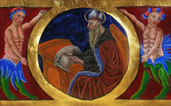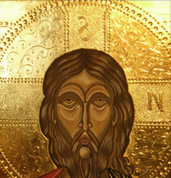Aron Basucci Ancient Paintings
In the beginning, when Almighty God created heaven and earth, above all animals and foods he created man and woman in his own image, endowing them with every virtue. Then, because of the misfortune which fell upon Adam, through envy, from Lucifer, who by his malice and cunning beguiled him--or rather, Eve, and then Eve, Adam--into sin against the Lord's command: because of this, therefore, God became angry with Adam, and had him driven, him and his companion, forth out of Paradise, saying to them: Inasmuch as you have disobeyed the command which God gave you, by your struggles and exertions you shall carry on your lives.' And so Adam, recognizing the error which he had committed, after being so royally endowed by God as the source, beginning, and father of us all, realized theoretically that some means of living by labor had to be found. And so he started with the spade, and Eve, with spinning. Man afterward pursued many useful occupations, differing from each other; and some were, and are, more theoretical than others; they could not all be alike, since theory is the most worthy. Close to that, man pursued some related to the one which calls for a basis of that, coupled with skill of hand: and this is an occupation known as painting, which calls for imagination, and skill of hand, in order to discover things not seen, hiding themselves under the shadow of natural objects, and to fix them[1] with the hand, presenting to plain sight what does not actually exist. And it justly deserves to be enthroned next to theory, and to be [p. 2] crowned with poetry. The justice lies in this: that the poet, with his theory, though he have but one, it makes him worthy, is free to compose and bind together, or not, as he pleases, according to his inclination. In the same way, the painter is given freedom to compose a figure, standing, seated, half-man, half-horse, as he pleases, according to his imagination. So then, either as a labor of love for all those who feel within them a desire to understand; or as a means of embellishing these fundamental theories with some jewel, that they may be set forth royally, without reserve; offering to these theories whatever little understanding God has granted me, as an unimportant practicing member of the profession of painting: I, Cennino, the son of Andrea Cennini of Colle di Val d'Elsa, -[I was trained in this profession for twelve years by my master, Agnolo di Taddeo of Florence; he learned this profession from Taddeo, his father; and his father was christened under Giotto, and was his follower for four-and-twenty years; and that Giotto changed the profession of painting from Greek back into Latin, and brought it up to date; and he had more finished craftsmanship than anyone has had since], -to minister to all those who wish to enter the profession, I will make note of what was taught me by the aforesaid Agnolo, my master, and of what I have tried out with my own hand: first invoking [the aid of] High Almighty God, the Father, Son, and Holy Ghost; then [of] that most delightful advocate of all sinners, Virgin Mary; and of Saint Luke, the Evangelist, the first Christian painter; and of my advocate, Saint Eustace; and, in general, of all the Saints of paradise, A M E N.Cennino Cennini, Il libro dell’arte SECTION. 1, XIV secolo








